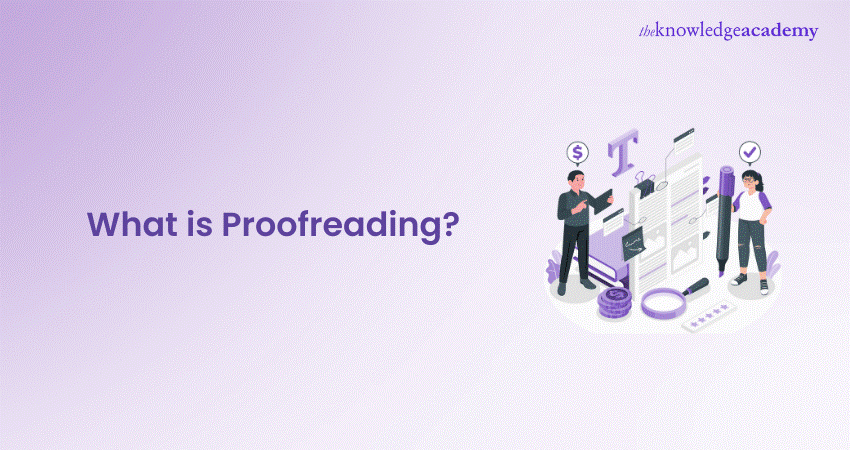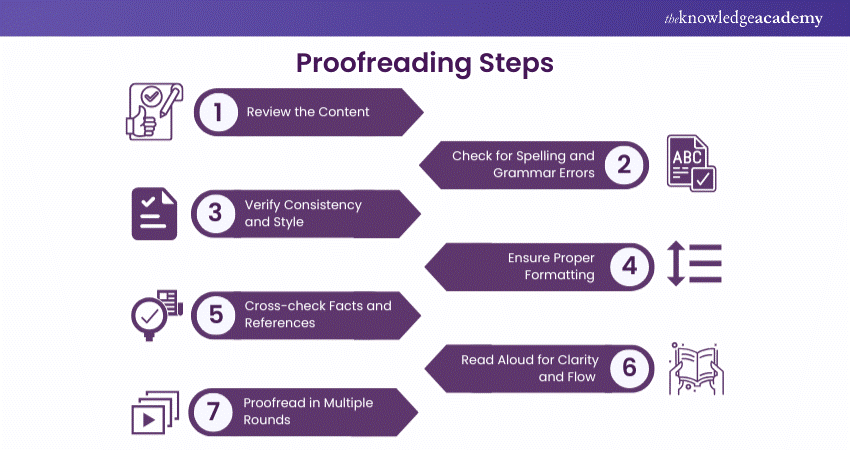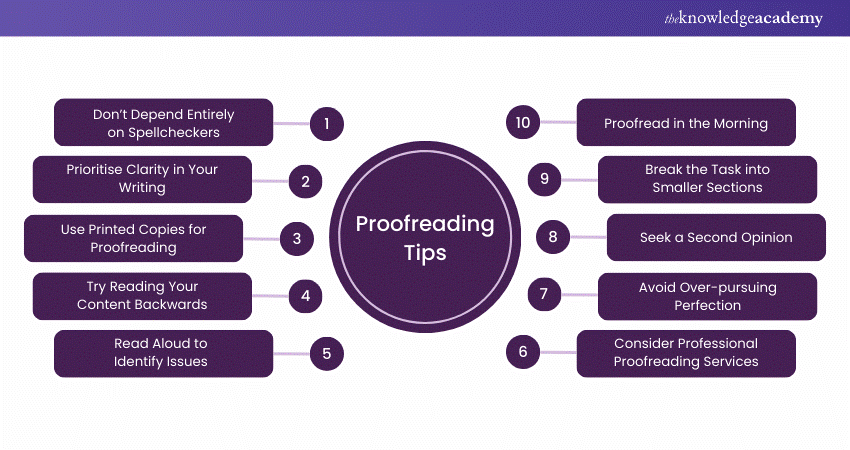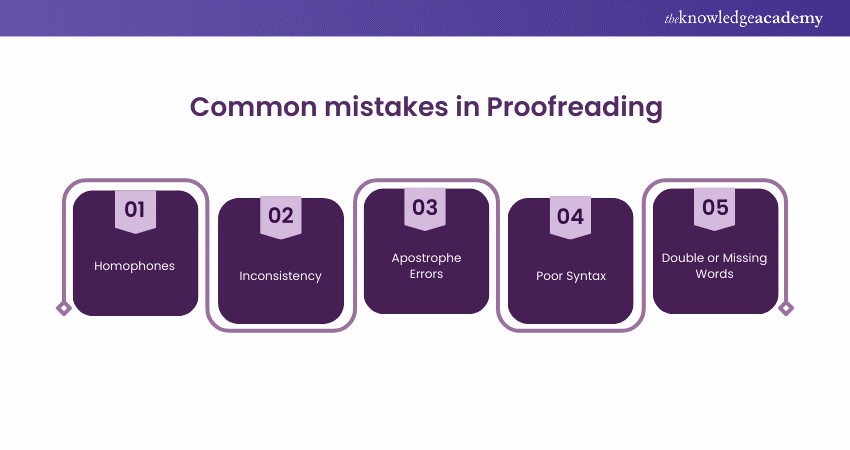We may not have the course you’re looking for. If you enquire or give us a call on +31 208081674 and speak to our training experts, we may still be able to help with your training requirements.
Training Outcomes Within Your Budget!
We ensure quality, budget-alignment, and timely delivery by our expert instructors.

Imagine preparing a piece of writing that captivates your audience completely. But what if you could eliminate errors and enhance clarity? This is where proofreading comes into play. But What is Proofreading? It’s more than just checking for typos and punctuation mistakes. Proofreading is a vital step in the writing process. It ensures your work is polished, professional, and ready for readers.
Whether you’re a student, professional, or a passionate writer, effective proofreading elevates your writing. This blog on What is Proofreading? unravel the intricacies of proofreading and provide a step-by-step guide. You’ll learn essential techniques to refine your work and engage your readers more effectively. Ready to transform your writing? Let’s dive in!
Table of Contents
1) Understanding “What is Proofreading?” and Its Aspects
2) Benefits of Proofreading
3) Step-by-Step Guide to Proofreading
4) Proofreading Tips
5) Conclusion
Understanding “What is Proofreading?” and Its Aspects
Before we move on to the step-by-step guide, we will first define Proofreading. Proofreading is the meticulous process of reviewing written content to identify and correct errors in grammar, spelling, punctuation, formatting, and overall clarity. Understanding Proofreading is essential for anyone involved in the writing process. Let's explore the key aspects of understanding Proofreading in more detail:

1) Thorough Examination of Content: Proofreading goes beyond a cursory read-through of a document. It involves a meticulous examination of the content to identify and rectify errors. This examination encompasses grammar, punctuation, spelling, formatting, consistency, style, and overall coherence.
2) Error Detection and Correction: The primary goal of Proofreading is to identify and correct errors in written materials. These errors can range from simple typos and grammatical mistakes to more complex issues like inconsistent formatting or unclear sentence structure. Proofreading ensures that these errors are identified and fixed, resulting in polished and error-free content.
3) Enhancing Writing Quality: Proofreading is an integral part of the writing process that contributes to improving the overall quality of the written work. By eliminating errors, Proofreading enhances the clarity, readability, and coherence of the content. It ensures that the message is effectively conveyed to the intended audience.
4) Attention to Grammar and Language: Proofreading involves paying close attention to grammar and language usage. It includes checking for proper subject-verb agreement, verb tenses, correct word choice, and sentence structure. Through Proofreading, inconsistencies and errors in grammar and language are identified and rectified, ensuring that the writing adheres to the rules and conventions of the English language.
5) Consistency and Coherence: Proofreading also focuses on maintaining consistency and coherence throughout the document. This includes checking for consistent use of terminology, formatting, headings, and citation styles. By ensuring consistency, Proofreading helps to create a cohesive and unified piece of writing that is easier for readers to follow and understand.
6) Attention to Detail: Proofreading requires a keen eye for detail. It involves scrutinising every aspect of the writing, including punctuation, spacing, indentation, and formatting. By paying attention to these details, Proofreading helps to eliminate errors and inconsistencies that might otherwise be overlooked.
7) Attention to Style and Tone: Proofreading considers the style and tone of the writing. It ensures that the content aligns with the desired style guide or guidelines. This includes checking for appropriate language usage, tone consistency, and adherence to specific writing conventions. Proofreading ensures that the writing maintains the intended style and tone, enhancing the overall effectiveness of the message.
8) Iterative Process: Proofreading is an iterative process that involves multiple rounds of review. Each round focuses on different aspects, such as grammar, spelling, formatting, consistency, or style. Through these rounds, errors are gradually eliminated, and the content is refined for optimal quality.
9) Final Check for Accuracy: Proofreading serves as the final check for accuracy before the content is published or shared. It verifies the factual accuracy of information, confirms proper citations and references, and ensures the overall integrity of the content. By conducting this final accuracy check, Proofreading helps to maintain the credibility and reliability of the written work.
Benefits of Proofreading
Proofreading is considered to be an important step in the writing process that offers numerous benefits. Let's explore the key benefits of Proofreading in more detail:
1) Enhanced Credibility and Professionalism: Proofreading ensures that your written content is free from errors, making it more credible and professional. When your work is polished and error-free, it demonstrates your attention to detail and dedication to producing high-quality materials. This, in turn, enhances your credibility and reputation as a writer or organisation.
2) Improved Clarity and Comprehension: Proofreading helps to clarify your ideas and improve the overall coherence of your writing. By eliminating errors, awkward phrasing, and unclear sentences, you make your content easier to understand for your audience. Clear and well-structured writing enhances comprehension, allowing your readers to grasp your message more effectively.
3) Minimised Misinterpretation and Confusion: Error-free writing reduces the risk of misinterpretation or confusion among your readers. When your content is clear and accurate, it ensures that your message is conveyed precisely as intended. This helps to avoid any misunderstandings and ensures that your readers correctly grasp the information or ideas you are trying to communicate.
4) Increased Professionalism in Communication: Whether you are writing an academic paper, a business report, or a blog post, Proofreading adds a professional touch to your communication. It shows that you take your work seriously and have a high standard of quality. Professionally proofread content reflects positively on your image and fosters trust and respect from your readers.
5) Improved Readability and Engagement: Proofreading enhances the readability of your content, making it more engaging for your audience. By eliminating errors, awkward sentences, and confusing phrases, you create a smooth and enjoyable reading experience. When your writing flows well and is free from distractions, readers are more likely to stay engaged and continue reading.
6) Maintained Brand Consistency: For businesses and organisations, Proofreading helps to maintain brand consistency across written materials. By adhering to consistent language, style, and tone, you reinforce your brand's identity and messaging. Consistent and error-free writing contributes to a cohesive and professional brand image.
7) Error-free Facts and References: Proofreading ensures the accuracy of facts, data, quotes, and references in your content. Cross-checking and verifying information during the Proofreading process helps you to avoid spreading misinformation or using unreliable sources. Accurate and properly cited information strengthens the credibility of your work and builds trust with your readers.
8) Reduced Embarrassment and Reputational Damage: Proofreading is a proactive measure to prevent embarrassing mistakes or errors that can damage your reputation. Typos, grammatical errors, or factual inaccuracies can undermine your professionalism and credibility. By thoroughly Proofreading your content, you minimise the risk of publishing content with avoidable mistakes.
9) Better Writing Habits and Skills: Regularly engaging in the Proofreading process helps you develop better writing habits and skills. By paying attention to the details and identifying errors, you become more conscious of your writing style, grammar rules, and formatting conventions. Over time, this improves your overall writing proficiency and enables you to produce higher-quality content.
Master the art of Attention Management and reclaim control of your time with our transformative Attention Management Training!
Step-by-Step Guide to Proofreading
Proofreading is an essential step in producing polished, error-free content. This section provides a step-by-step approach to ensure your writing is clear, consistent, and professional.

1) Review the Content
Begin the proofreading process by thoroughly reviewing the entire content. This step allows you to gain a comprehensive understanding of the material, its purpose, and the target audience. As you review, take note of any areas that require attention or improvement.
2) Check for Spelling and Grammar Errors
Next, meticulously check the content for spelling and grammar errors. Look for common mistakes such as typos, misspelled words, incorrect verb forms, subject-verb agreement issues, and punctuation errors. While using spelling and grammar check tools can be helpful, remember that they are not foolproof and should be complemented by a manual review.
3) Verify Consistency and Style
Consistency in writing is essential for maintaining a smooth flow and ensuring reader comprehension. Check that the terminology, formatting, headings, and citation styles are consistent throughout the document. Adhere to the specified style guide, such as the Oxford Style Manual or The Guardian Style Guide, to maintain a unified and professional appearance.
4) Ensure Proper Formatting
Formatting plays a significant role in the overall presentation of the document. Pay attention to font styles, sizes, line spacing, margins, and indentation. Ensure that formatting is consistent throughout and aligns with the required standards or guidelines. Well-formatted content enhances readability and presents a polished document.
5) Cross-check Facts and References
For content that relies on facts, data, or references, it is crucial to cross-check their accuracy and reliability. Verify the information, statistics, quotes, and references against credible sources. Ensure that all facts are properly cited and attributed. This step helps maintain the credibility of the content and prevents the spread of misinformation.
6) Read Aloud for Clarity and Flow
Reading the content aloud is an effective technique to assess its clarity, flow, and overall effectiveness. Pay attention to sentence structure, paragraph coherence, and the overall tone of the writing. Reading aloud helps identify awkward phrasing, unclear sentences, and areas that may require rephrasing or restructuring to improve reader understanding and engagement.
7) Proofread in Multiple Rounds
To ensure thorough proofreading, it is recommended to conduct multiple rounds of review. Each round can focus on specific aspects such as grammar, spelling, consistency, formatting, and style. Taking breaks between rounds allows you to approach the content with a fresh perspective, making it easier to spot any overlooked errors or areas for improvement.
During each round, carefully review the content, making necessary corrections and adjustments. Pay attention to the changes made in previous rounds to ensure consistency and accuracy throughout the document. This iterative process helps refine the content and ensures its quality.
Proofreading Tips
Effective proofreading is essential for producing clear, error-free content. By following a few key strategies, you can significantly enhance the quality of your writing. These tips will help you catch common mistakes, improve clarity, and ensure your work is polished and professional.

1) Don’t Depend Entirely on Spellcheckers: While spellcheck tools are useful, they can miss context-specific errors, so it’s essential to manually review your content to catch mistakes that automated tools might overlook.
2) Prioritise Clarity in Your Writing: Aim for clear and straightforward language to ensure your message is easily understood by readers. This involves simplifying complex ideas and avoiding ambiguous wording.
3) Use Printed Copies for Proofreading: Reviewing a printed version of your content can help you notice errors that might not be as apparent on a screen. If you choose this method, consider eco-friendly practices like planting trees to offset paper use.
4) Try Reading Your Content Backwards: Reading the text from the end to the beginning can help you focus on individual words and phrases, making it easier to spot spelling and grammatical errors that might go unnoticed in a normal read-through.
5) Read Aloud to Identify Issues: Speaking your content aloud can help you detect awkward phrasing, run-on sentences, and other issues that might affect the flow and clarity of your writing.
6) Proofread in the Morning: Tackling proofreading tasks in the morning when your mind is fresh can improve your ability to spot errors and inconsistencies in the text.
7) Break the Task into Smaller Sections: Dividing the proofreading process into smaller, manageable parts can make it less overwhelming and help maintain focus, leading to a more thorough review.
8) Seek a Second Opinion: Having a friend or colleague review your content can provide a fresh perspective and catch errors you might have missed, improving the overall quality of your work.
9) Avoid Over-pursuing Perfection: While it's important to aim for high-quality writing, chasing absolute perfection can be counterproductive. Focus on making your content clear, accurate, and polished without getting bogged down by minor imperfections.
10) Consider Professional Proofreading Services: If you’re unsure about your proofreading skills or need a final polish, hiring a professional proofreader can ensure your content is free from errors and meets the highest standards.
Common Mistakes in Proofreading
Proofreading is a crucial step in writing, yet even the most experienced writers can overlook common errors. Whether it's a double word, a misplaced apostrophe, or an unnoticed homophone, these mistakes can slip through the cracks if you're not careful. Let’s explore the five most common proofreading errors and how to catch them.

1) Homophones:
Homophones are words that sound alike but have different meanings, such as "bare" and "bear." These tricky words often evade spell checkers because they are correctly spelled but wrongly used. To catch these, you need to be extra vigilant and perhaps read your work aloud to notice when something doesn’t sound right.
2) Inconsistency:
Inconsistencies are subtle yet common errors in writing. They can involve dates, spelling variations, or even formatting. For instance, using "March 8th, 2021" in one place and "8 July 2021" elsewhere can confuse readers. The key to avoiding this is to maintain consistency in your writing style, whether it's the format of dates, the use of British or American English, or the application of hyphens and dashes.
3) Apostrophe Errors:
Apostrophes are small but mighty, often causing confusion when misused. They serve two main purposes: indicating possession (e.g., "John’s book") and forming contractions (e.g., "it’s" for "it is"). A misplaced apostrophe can change the meaning of a sentence entirely, so it’s essential to use them correctly.
4) Poor Syntax:
Syntax refers to the structure of sentences and the order of words. Poor syntax can result in awkward or confusing sentences. For example, "She served sandwiches to guests on paper plates" could be rephrased as "She served sandwiches on paper plates to guests" to make the meaning clearer. Proofreading with a focus on sentence structure can help ensure your writing is clear and effective.
5) Double or Missing Words:
One of the most common proofreading mistakes is accidentally repeating or omitting words. These errors can easily slip through if you’re typing quickly or not paying close attention. Always take the time to read through your work slowly and carefully and consider using a spell checker to catch these mistakes, though it’s also wise to manually review your text for the most thorough proofreading.
Conclusion
Proofreading is a critical process in the journey of producing impeccable written content. By following the step-by-step guide outlined in this blog, you can improve the accuracy, clarity, and professionalism of your writing. Remember to dedicate ample time and attention to each stage of the Proofreading process to ensure optimal results. Hope this blog answered all your questions on What is Proofreading!
Ignite your personal development journey with our comprehensive Personal Development Training and unlock your true potential today!
Frequently Asked Questions

Ensure clarity, grammar, spelling, punctuation, and consistency. Check for accurate facts, smooth transitions, correct formatting, and overall readability. Focus on sentence structure, style, and adherence to guidelines.

To proofread effectively, start by reading your text aloud to ensure clarity. Take breaks between editing sessions to approach your work with fresh eyes. Utilise digital tools to catch spelling and grammar errors. Concentrate on one issue at a time and consider printing your document to gain a new perspective.

The Knowledge Academy takes global learning to new heights, offering over 30,000 online courses across 490+ locations in 220 countries. This expansive reach ensures accessibility and convenience for learners worldwide.
Alongside our diverse Online Course Catalogue, encompassing 19 major categories, we go the extra mile by providing a plethora of free educational Online Resources like News updates, Blogs, videos, webinars, and interview questions. Tailoring learning experiences further, professionals can maximise value with customisable Course Bundles of TKA.

The Knowledge Academy’s Knowledge Pass, a prepaid voucher, adds another layer of flexibility, allowing course bookings over a 12-month period. Join us on a journey where education knows no bounds.

The Knowledge Academy offers various Personal Development Courses, including the Creative Writing Course, and the Report Writing Course. These courses cater to different skill levels, providing comprehensive insights into Proofreading Tips and Techniques.
Our Business Skills Blogs cover a range of topics related to Personal Development, offering valuable resources, best practices, and industry insights. Whether you are a beginner or looking to advance your Business skills, The Knowledge Academy's diverse courses and informative blogs have got you covered.
Upcoming Business Skills Resources Batches & Dates
Date
 Report Writing Course
Report Writing Course
Fri 6th Dec 2024
Fri 14th Feb 2025
Fri 11th Apr 2025
Fri 13th Jun 2025
Fri 15th Aug 2025
Fri 10th Oct 2025
Fri 12th Dec 2025







 Top Rated Course
Top Rated Course



 If you wish to make any changes to your course, please
If you wish to make any changes to your course, please


